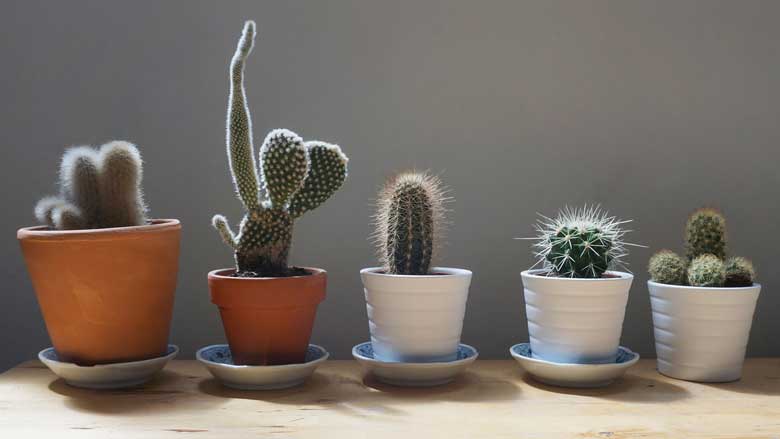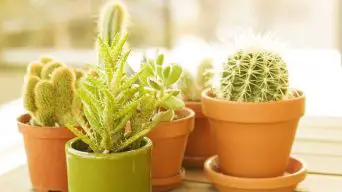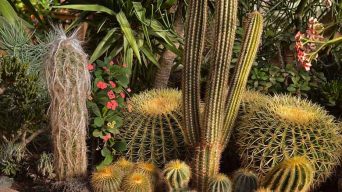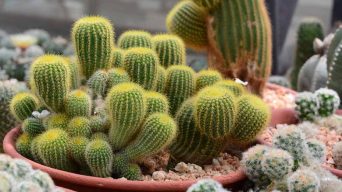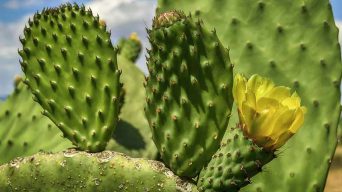To care for small cactus plants, provide bright, indirect sunlight for at least six hours daily. Water sparingly, allowing the soil to dry between waterings. Use well-draining cactus soil and fertilize every 2-6 weeks during the growing season. Watch for pests like mealybugs, scale insects, and be cautious of diseases like root rot. Maintain temperatures between 55-80°F, reduce watering in winter, and avoid prolonged exposure to cold. With minimal pruning and proper attention, these charming mini cacti thrive indoors.
Small cactus plants may be tiny in size, but they stand out as highly rewarding additions to your indoor space. These houseplants require minimal care and present an array of fascinating small flowers.
This guide is tailored for those eager to understand the essentials of caring for little cactus plants, making it particularly useful for beginners in gardening.
We’ll delve into all the necessary steps to cultivate mini cacti indoors. Join us on this informative journey and enrich your knowledge of nurturing these delightful succulents!
Types of Mini Cactus Plants
There are many small cacti species available to choose from. Miniature cacti are tiny and easy to care for, making excellent indoor houseplants.
Small cacti with different shapes, colors, and textures are available. You can get a plant with long, short, or no spines, depending on the type of cactus plant you want.
There are many types of mini cactus plants. The most common ones available at home and garden stores include:
- Ariocarpus fissuratus (Living Rock Cactus)
- Cephalocereus senilis (Old Man Cactus)
- Gymnocalycium mihanovichii (Moon Cactus)
- Echinocereus arizonicus (Arizona Hedgehog Cactus)
- Escobaria vivipara (Ball Cactus)
- Mammillaria elongata (Gold Lace Cactus)
- Mammillaria hahniana (Old Lady Cactus)
- Mammilloydia candida (Snowball Cactus)
- Stenocactus multicostatus (Brain Cactus)
Caring For a Mini Cactus Plant
Numerous small cactus plants share similar care requirements. This cactus care guide provides insights for growing vibrant and robust small cacti.
Sun Exposure & Light Requirements
Cactus plants are hardy, but achieving the correct sunlight balance is crucial.
While ensuring they receive adequate sunlight is essential for their well-being, an excess or deficiency can impact their growth. Therefore, proper sunlight care is key to maintaining their health and vibrancy.
Just ensure your plant gets enough sun during the day and do not get intense direct sunlight for too long. They need at least six hours of bright light each day.
The most important thing is that your plant receives bright light (preferably natural) but that they do not get direct sunlight.
A south-facing windowsill is the ideal spot for most cacti, especially smaller ones that require ample sunlight throughout the day.
You might need to rotate your plant every once in a while so they don’t end up with their leaves all facing the same direction and getting sunburned.
Excessive exposure to direct sunlight can result in sunburn for a cactus.
Some light exposure is always beneficial, but ensure your cactus is not in a full sun spot for a prolonged period.
Water Requirements
Small cactus plants need only small amounts of water. Most cacti will require a thorough watering once a week.
Miniature cacti may be watered less frequently as they have smaller root systems that can dry out quickly.
The time between waterings depends on the size and type of pot you are using to grow your small plant.
A cactus plant should only be watered when the soil has completely dried. This will prevent rotting and ensure your small plant can absorb moisture efficiently.
If you’re unsure how often a mini cactus needs water, avoid watering until you notice signs of wilting or drooping leaves.
When watering cactus plants, allow the soil to drain before placing the plant upright. This prevents water from accumulating at the base, reducing the risk of root rot or fungal infections.
This is especially important when growing small succulents as they can dry out much faster than other types of small cacti if not given enough time between watering sessions. Ensuring proper care, such as monitoring the soil moisture levels, becomes crucial in preventing issues like dehydration.
Soil Requirements
Indoor cacti generally require very little maintenance or care besides occasional watering.
However, the potting mix you choose can make all the difference between growing healthy mini cacti indoors vs. those that die quickly from overwatering or undernourishment.
Regarding small cacti, the most important factor is choosing a good potting mix and ensuring proper drainage.
A Cactus plant needs light, sandy soil that drains well. It grows particularly well in porous soil.
A Cactus soil mix is ideal because it contains small peat particles and small pumice rocks for good drainage.
One of the best potting soil mixes is a cactus mix with added perlite, which helps create better aeration by adding more spaces between soil particles so that your small cacti can grow stronger more quickly.
If you buy your soil, ensure it is for small plants and a cactus/succulent potting mix, taking extra care to avoid store-bought soils with fertilizers or other additives because the extra nutrients may harm your plant.
Temperature and Humidity Requirements
To grow, cacti require particular temperatures and humidity levels. Cacti are desert plants, so they are accustomed to hot, dry conditions, making them a perfect fit for a home environment replicating their natural habitat.
While caring for small cacti, it’s important to note that they can thrive in lower humidity levels than other houseplants, with the ideal range being 30-60%.
In addition, cacti prefer warm conditions and need to be kept in the range of 55-80º Fahrenheit. They cannot tolerate cold temperatures below 50 degrees Fahrenheit.
Fertilizing Needs
Mini cactus plants are small and slow-growing, requiring small amounts of fertilizer.
Feed cactus plants once every two to six weeks during their growing season using a water-soluble fertilizer mixed at half the strength.
Small cacti are sensitive to chemical fertilizers, so it is best to use an organic fertilizer.
Be cautious not to overfeed small cacti because excessive fertilization may lead to fertilizer burn, harming their delicate roots.
Potting and Repotting
It would be best to use a compact container for small cacti, as these plants don’t need much space to thrive, and they will do best when their roots are not disturbed too often.
While this varies between different cactus types, most will grow best in clay pots. They allow proper aeration and moisture retention while giving the roots room to breathe, preventing root rot from forming.
When picking out planters for your cactus indoor garden, avoid pots made from plastic or metal. They will not retain moisture properly, and there is a high chance that small cacti won’t do well in them.
When the cactus plant has filled out enough, you can consider repotting it into a larger container if needed. This process ensures that the plant has sufficient space for growth and allows for proper aeration of the roots.
If your cactus garden has too many cacti in a small container, you can repot them into an appropriately sized pot.
This is only necessary if the small plant has filled out enough that its roots grow through the drainage holes at the bottom of your planter or begin sticking up above the soil surface.
When it comes time to transplant small cacti, work with succulent plants at least two years old.
If you transplant small ones too early, they might not have good root systems, making it difficult to establish themselves in the new soil.
Pruning
Most small cacti do not require pruning due to their size and slow growth, which generally eliminates the need for pruning.
Trimming your cacti branches should be limited to removing dead or damaged growth. Utilize small pruning shears or sharp scissors, specifically at the end of the branches.
When removing growth, focus on small sections not integral to the main plant structure. Be cautious around growing points, as pruning in these areas may cause harm to the small plant.
Pests
Cactus plants are susceptible to small bugs and pests.
You must know how to eliminate them before they start destroying your small cacti plants.
Two common tiny garden pests affecting small cactus plants are scale insects and mealybugs.
These little creatures suck out the sap of small cacti, leaving small cacti plants weak and defenseless.
Mealybugs
These tiny bugs live in colonies on the surface of cactus leaves and stems, posing a threat to your garden.
To prevent them from further weakening your plants, it’s essential to control their population.
They feed by sucking out small plant juices, and mealybugs, in particular, make small cotton-like substances that you can remove with warm water or a mild soap solution.
Scales
Scale insects are small, flat, and brownish, with a broad waxy layer on their bodies, making them look like small cones or shells.
They lay eggs under this protective wax cover, which hatch as small crawlers looking for new plants to infest.
You can manage a small scale infestation by removing and eliminating them from petite cactus plants.
Diseases
There are some diseases that cactus gardeners have to watch out for, and proper care is crucial in preventing them.
Two common diseases affecting cactus plant health are root rot and fungal infections, especially when the soil is too wet or soggy.
Root Rot
This disease affects cacti when they are exposed to excess moisture.
Symptoms of this disease include:
- Browning and dying roots.
- Small yellow leaves fall off the plant.
- Wilting or drooping small stems and branches.
- Rotting stalks.
Fungal Infections
With a small cactus, fungal infections are common when gardeners do not water their small plants enough.
Symptoms of this disease include small fuzzy growths on the surface and around your plant base, a sign that fungi have invaded it.
The two most effective ways to prevent these diseases from attacking your small cacti are by using clean soil and watering only in the early morning hours, so there’s time for excess moisture to dry out before nightfall.
Additionally, always use a well-draining potting mix or loose soils with at least 50% peat moss content, as these can help ensure the successful cultivation of small succulents indoors while promoting good air circulation around the roots.
Winter Care For Small Indoor Cacti
Winter can be tough on small cactus plants.
They are not designed to stand the cold, and if you happen to live in a place where winter temperatures go below 40F (5C), your small indoor cactus plant will need some extra care during this period, taking care to shield it from harsh weather conditions.
As mentioned before, cacti thrive best at room temperature between 55-80° F. You should try to maintain these temperatures throughout the year as much as possible because it helps prevent bud drop and makes your succulent plant healthier overall.
Placing mini cactus plants near a window is also acceptable, but keep an eye on them to ensure they aren’t getting too much sunlight.
Another thing to do during winter is to reduce watering slightly because your small cacti might have less water requirements during colder periods.
Usually, once every two weeks should be suitable for most cactus types, but you can also increase the time to once or twice a month if your cactus is not doing well.
Feel the top of the soil to see if your houseplant requires water. If it’s dry or feels light, it needs watering.
As long as you do the things mentioned above, with proper care, your cactus should survive winter just fine.
Final Thoughts
Compact and adorable, small cactus plants are easy to care for and serve as an excellent addition to any home.
Available in various shapes, colors, and textures, they are ideal for indoor plants.
Whether you’re seeking to introduce a bit of greenery to your cozy apartment or searching for a charming mini cactus as a thoughtful gift, these petite succulents are the perfect option to infuse a natural touch into your living space.

